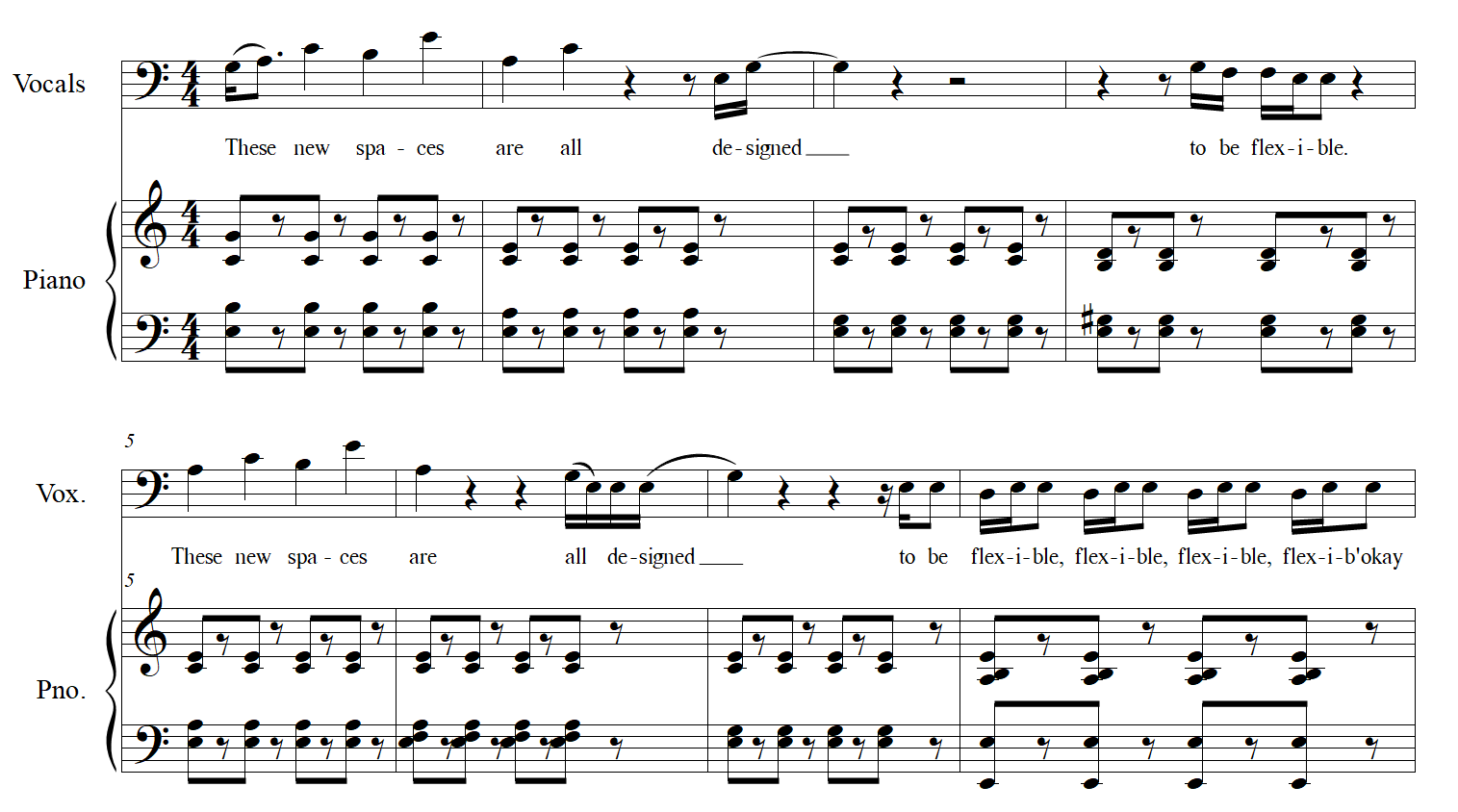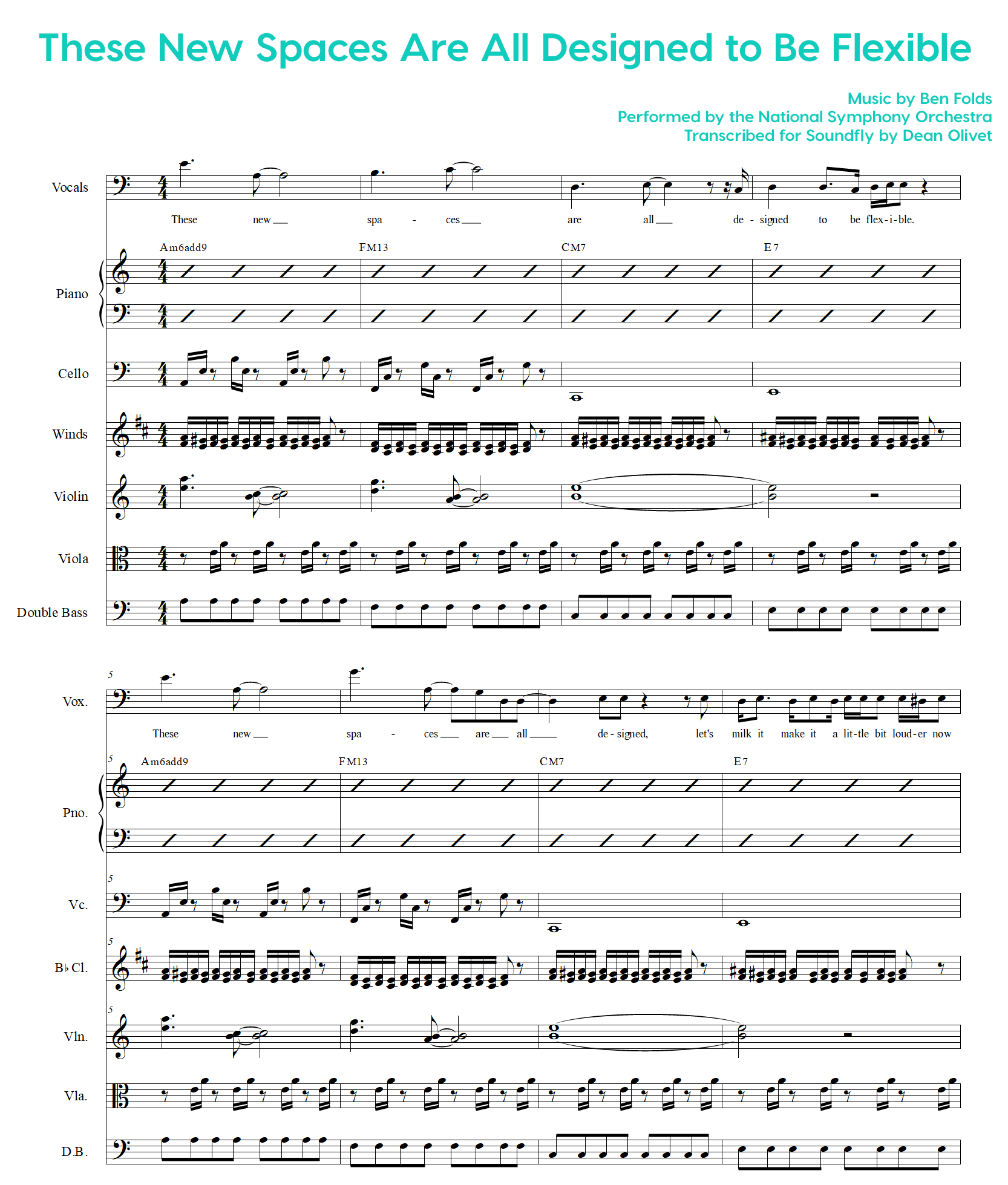A little over a week ago, the Kennedy Center uploaded a video of a concert in which singer-songwriter and composer Ben Folds creates an orchestral piece of music in under 10 minutes and performs it with the full participation of the National Symphony Orchestra. The video, which has since been shared over 100,000 times, is a window into the creative process of one of the most beloved songwriters of our time. It also reveals some fundamental tactics for quick composing, such as using limitations to your advantage and relying on tried-and-true forms but eschewing the obvious.
If you haven’t seen it, and even if you have, please watch this incredible performance below.
In order to write a song on the spot without any planning — and get 50 professional instrumentalists to play along — you can’t exactly start from scratch. There’s going to have to be some tools and lumber delivered to the work site, i.e., accessible musical patterns and conventions already familiar to everyone involved.
We’re going to take a look at those patterns and how Folds embellishes, tweaks, and deviates from them to craft what turns out to be a pretty catchy tune! In fact, we love this tune so much, we transcribed the whole dang thing. Follow us as we break it down minute by minute, and watch an exclusive video from our five-week, mentor-driven Orchestration for Strings course demonstrating how to make use of some of the same tactics Folds uses to compose homophonic textures for a string ensemble.
@ 0:31
The concrete truck comes to pour Folds his foundation of inspiration. For harmony and rhythm, the song will be in the key of A minor and use an “upbeat” tempo. The melody will be based on the sentence, “These new spaces are all designed to be flexible.” Time to pound some nails.
@ 1:39
Folds sets a lighthearted mood by cracking a Beethoven joke, although he plays the wrong interval — a minor third rather than a major third. I point this out not to be a jerk, but to highlight that the reason the audience still gets the joke is because it indicates just how iconic the rhythm and shape of that four-note line is in Western music. Seeing as the interval wasn’t even correct, would the joke have still landed if the note went up or the rhythm been altered?
Possibly! Anyway, let’s move on.
+ Learn more on Soundfly: Create more powerful, emotional experiences in your music by understanding harmonic theory. Our brand-new course, Unlocking the Emotional Power of Chords, can help you get there quicker!
@ 1:52
Folds’ fingers hit the keys. His right hand plays a duple meter, his foot taps a triple meter, and his left hand plays, well… the left hand just does what it does. Below are three measures that approximate what he comes up with. I didn’t transcribe the toe tap, but if I had, it would have looked like three quarter notes per measure.

It’s not clear whether he’s started writing or whether he’s merely stoking the fire like a track runner shaking and warming up his or her muscles before the race. But things are certainly starting to take shape.
@ 2:12
Either way, Folds keeps a few of these LEGO pieces, leaving his fingers where they landed on that first chord. Now, we’re treated to Folds’ creative process in full swing.

Chords begin to cement into place. If I’m hearing them right, we’ve got CM7/E, Am7/E, C/E, and E7. Then, he tries something a little different with Am7/E, FM7/E, C/E and an Esus7. Whatever they are, they’re all diatonic — chords in the key of A minor — so no tweaking yet. Speaking in terms of roman numerals, like ya do, we’ve got some fancy extensions, inversions, and a suspension of the three (♭III), one (i), five (V), and six chord (♭VI).
Lyrically, he eases in, putting all the syllables right on the beat, then, when he starts running out of his sentence, takes a break, rationing the words he has left so they disperse over the familiar four-bar frame. The four-bar phrase is one of the least violated conventions in songwriting. You can stack them — 8, 12, 16 — but for one heck of a challenge, try breaking this norm sometime. It’s treacherous.
Another lyrical tool he’s using here is something called word painting. It’s where the music itself takes on characteristics of the lyric. Listen at 2:34. He’s slurring and wobbling like a musical saw — “flexible” indeed. It’s something Katy Perry notably did not do in her song “Rise,” written for the 2016 Olympics, in which the chorus melody descends as opposed to the lyrics suggesting it, well, rise.
Speaking of slidy-slurry things, it’s the cellos’ turn to get picked first this week.

@ 3:08
He takes a note away to create variation in the pattern. Think of it like punctuation in a sentence. A punctuation obsession benefits writers of any kind when delineating where and how their motifs start and stop.
@ 3:25
Notice how Folds feels the need to point out the “nine” to the cellos. He thinks to do this because nines aren’t usually found in chord patterns. There’s a chance musicians might default to the octave if not specified by him. He didn’t point out the “five” in that pattern because, I mean, obviously, there’d be a “five!”
See? Utilizing accepted foundations and forms do communicate well in large ensembles.
@ 3:56
Listen very carefully to the cellos. Did you hear it? Listen again. There’s a wrench in the works. We’ll find out what in a minute, but first, the wind part, workshopped by the clarinets.
@ 4:18
He starts cooking up another arpeggio-type thing, but at 4:41, he changes his mind, probably because he feels it’s too similar to the 1-5-9 arpeggio cello thing he’s just composed. He wants something to contrast and complement, so he goes in an opposite direction. Now instead of motifs spanning over an octave, he limits the motifs to harmonized, single-scale steps adjacent notes in the A-minor scale.

@ 5:41
We get another hint about that wrench in the works. This time from the clarinets.
@ 6:00
Folds notices it, too. Earlier, at 3:40, he indicated that he wanted the arpeggiated bits to last two bars, creating a six-bar phrase with the added whole notes. But, like I said, the four-bar phrase is a hard nut to crack; both the cellos and the clarinets default to four bars, even with his stated preference. Folds doesn’t fight the current and lets it push his raft past this little boulder and down the stream.
@ 6:40
Folds raises the G in the repetition of his rippling river winds part to a G# — also known as the leading tone in A minor! This particular convention, raising the seventh scale degree, is still the most common tonal modification in the minor mode, as it changes its wimpy minor triad “v chord” to a dominant major triad “V chord,” making it tonally functional. Now we’re in the harmonic-minor zone, baby, keeping it real.
+ Read more on Flypaper: “How to Overcome Musical Boredom? Make ‘Incorrect’ Music Instead!”
@ 7:00
Folds teaches the violins their parts over bass notes and chords on the left hand for reference. Hey, how about some dotted quarter notes? Haven’t used those yet. And don’t you just love how those wide-to-tight harmonies come together at 8:14?

@ 8:36
For the violas’ loop, Folds takes this sandwich of changing chords and patterns and spears it with a toothpick by exercising his right to write a motif that doesn’t change at all. This is called an ostinato. (Watch our video below on ostinatos and homophonic texture.)

@ 9:02
Now, it’s time for bass and drums. Folds is pressed for time here, so it’s just the root bass notes. I’d bet he’d have fit in some of the inversions from the original idea or maybe a rhythmic pattern here or there if he’d had the time. Thus, “Double basses, you know what you must do.”

@ 9:22
Drums, “You know what to do,” too. Poor drums and basses; they rarely get to break from the patterns. Of course, the reality, and the reason everyone laughs so hard at this line, is that drummers and bassists are used to being an after-thought and are used to the popular conception that all they do is follow the lead. Of course, this isn’t always the case, as with polyrhythmic and syncopated groove composing. The rhythm section often drives music, even if perhaps still from the back seat of the station wagon.
@ 9:50
After some final brainstorming, it’s go time. Folds forages a verse for the song by improvising a melody from the text in the program, which I won’t transcribe, but I will point out the raised sixth scale degree he sings on “brin-GING” at 10:31 — very cool note after the non-raised seventh scale degree gives it a Dorian bent. Yum.
@ 11:16
We’ve come full circle back to the original chorus idea based on the original parameters. And don’t get your coattails crossed, but I ordered the score chronologically instead of using standard staff placement. Just watch out; I once knew a guy who had a heart attack after seeing the cellos outside of their strings bracket. You’ve been warned.
Now, here’s what you’ve surely been waiting for — the full transcription of Ben Folds’ impromptu piece lyrically starting from the chorus.

Over this fully orchestrated finalized chorus, the prosody of the lyric is especially improved, spreading it out over the bars evenly without being predictable. This is a knack that comes from being a creative songwriter for years and years.
It’d be interesting to compare this final chorus idea with the original in more ways than lyrics, but like Mr. Folds, I’m running out of time. You’ve got the scores, so why not see if there’s anything you can spot and leave it for us in the comments?
@ 11:43
We’ve now played around plenty with four of the five basic elements of music: melody, harmony, rhythm, and timbre, so now it’s time to monkey with the “expression” knobs, going from a regular volume of mezzo-forte (mf) all the way up to a “fivetissimo” (FFFFF!).
Five friggin’ tissimos! Now that’s dynamic they must have used all the time in Folds’ band, Ben Folds Five.
@ 12:12
A conventional rock ritardando, and there you have it: a song in 10 minutes! We’ve seen fecund ideas bouncing off of each other like sonic billiard balls — word painting, leading tones, arpeggios, prosody, ostinatos, fivetissimos, suspensions, extensions, inversions! We’ve seen a master craftsman at the beating heart of his craft, we’ve seen how creative conventions can speed up but also stifle the end product. And the only question that remains is who’s got dibs on the remix?
Don’t stop here!
Continue learning about music theory, composition, arrangement, harmony and chord progressions with Soundfly’s in-depth online courses, like Unlocking the Emotional Power of Chords, The Creative Power of Advanced Harmony, and Orchestration for Strings. Subscribe for unlimited access here.




